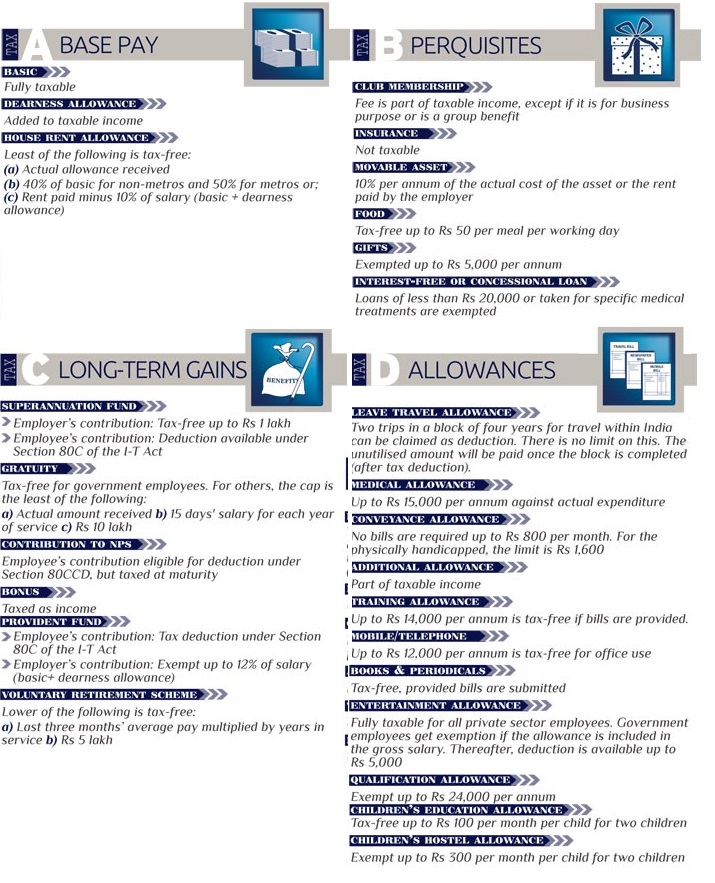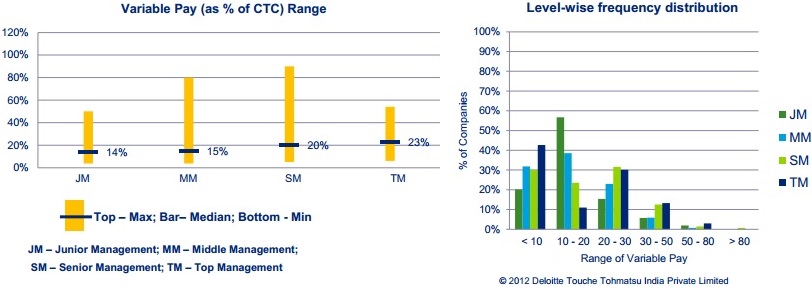Not long ago, the concept of Variable Salary hardly existed in India. Today employees, especially at managerial levels, find a part of their compensation depending on the sector, listed as variable pay .Variable pay, also known as performance pay, is used to recognise and reward employee contribution above and beyond their normal job requirements. This article talks about Salary breakup, Variable Pay, Variable Pay Trends.
Table of Contents
Salary breakup
Salary consists of following components:
- Base Pay : Has usually components such as Basic Salary, house rent allowance or HRA and dearness allowance. Dearness allowance (given mostly to government employees) is a percentage of basic pay and is paid to lower the impact of inflation.
- Long Term benefits : Contributions towards long-term and retirement benefits such as Provident fund, Superannuation fund and Gratuity
- Benefits and Perquisites : such as leaves, medical, car, insurance
- ESOPS : Employee stock options mainly, stock options and restricted stock units or RSUs
- Variable salary: includes Performance based incentive called as Variable Pay , Sale based incentive and Profit based bonus.
- Variable Pay is expressed as percentage is based on two main factors, employee’s own performance and his company’s performance. Companies have a actual payout based on that combination.
- For sales people, variable pay plus sales incentives can range from 30% to 40%. Sales incentives aren’t defined as variable pay as they are commissions.
Except for statutory heads such as Employee Provident Fund (EPF), gratuity and bonus, where the rules prescribe minimum contributions, there are no set rules on structure of the salary. Our article explains Salary, Net Salary, Gross Salary, Cost to Company: What is the difference in detail.
From Business Today Making Every Rupee Count
Variable Pay
Variable pay or performance pay, expressed as percentage is based on two main factors, employee’s own performance and his company’s performance. Earlier restricted to sales and marketing positions, now these are common across sectors. Companies have a actual payout based on combination of company’s and employee performance. As you climb up the hierarchy, the variable pay increases. In variable pay scheme an employee will get money depending on he achieving his targets and company also has achieved its targets. Fixed pay is generally decided on the basis of employee’s job, role in the company. The fixed to variable pay ratio is directly proportional to an employee’s job role, and is a quantifiable amount of his contribution towards the growth of the company. For example if variable pay is 15% then 85% of an salary is fixed. If the employee’s yearly salary is Rs 100 then he gets 85 Rs irrespective of his performance or his companies performance and the 15 Rs he will get if he and company achieved their targets
|
Rating
|
% of Variable pay based on Employee Rating
|
|
5
|
80%
|
|
4
|
70%
|
|
3
|
60%
|
|
2
|
50%
|
|
1
|
30%
|
Companies performance also plays a role in variable pay, If company has done well it would pay higher percentage of variable pay. If company has not done well, it may pay less variable pay or not pay at all.
Generally the variable percentage increases as one moves higher in the organisation’s hierarchy. Some approximate numbers for variable pay are
- At junior level, variable pay ranges from 10% to 15% of fixed pay.
- At middle level, it ranges from 15% to 30% and at senior levels, it is typically between 30% to 50%.
- At very senior levels, ESOPs and RSUs are also given above target levels as additional performance incentives.
Some features of Variable Pay are :
- Variable Pay is shown as part of Company’s CTC.
- Variable Pay is taxable based on individual’s tax slab.
- The catch with variable component of salary is that in case you leave the company before the financial year ends, you have to forgo this amount
Variable pay started gaining importance in the Indian market in the last decade. Largely a Western concept, it came into Asia and emerging markets like India and China, migrating with the Multinational Companies (MNCs). But Indian companies are now progressing on a par with the West, since the best part about variable pay is that it’s performance-linked. Even Govt companies such as PSUs are now moving towards it though the percentage there is typically not as high.
How is variable pay beneficial to the company?
Variable pay has become an increasingly popular mode of compensation in most companies.
- It helps company to reduce their fixed costs and increase variable costs,as variable gets paid out only on meeting some results.
- Companies also use variable pay to drive performance culture
- Companies use it to attract and retain talent since talented people wants to be differentiated for their performance.
The variable pay received does not solely depend on individual performance, the company’s financial results matter too. If the previous year was a tough one company may not disburse variable pay at all or give a lesser percentage. Some companies may be looking at increasing the variable component this year due to the pressure on the economy.
Advocates of the plans say Variable pay allowz employees to participate in the prosperity of their employers. But critics say the plans are also part of a broader transfer of risk from employer to employee that has in recent decades led to the demise of company-paid traditional pension plans etc.
Indian Companies and Variable Pay
The Compensation Trends Survey 2012 Deloitte Human Capital Advisory Services (pdf) reveals that the variable pay spread ranges from 10% to 30%, especially at the middle and senior management levels, and has shown a considerable decrease as compared to 2011 -2012. Variable pay has reduced the most (across all industries) for top management by 2.5 percentage points. Also, the higher payout is expected to be at 30% as compared to 41% last year. Financial services, FMCG, FMCD and healthcare are sectors which are very high on variable pay though other sectors are also following suit.
- The average Variable Pay across all industries is 16%
- Variable Pay across industries has mostly remained the same or reduced as compared to last year
- The exception to this is the Manufacturing sector where the Variable Pay has significantly increased
- Information Technology, ITeS, „Energy & Resources‟, „Infrastructure & Real Estate‟ and „Media & Advertising‟ are paying the same
- Variable Pay at median levels in 2012 as they did in 2011
- Consumer Business & Retail has shown a marginal increase in Variable Pay as compared to last year
- In the Financial services sector, there is a clear indication of companies moving to a more Fixed Pay structure with less dependence on the Variable Pay
- Variable Pay is lower at the Middle and Junior Management levels. At these levels, a higher emphasis is laid on the unit and team level performances for disbursal of variable pay. The compensation at these levels is driven by a higher Fixed Compensation
Related Articles :
- Salary, Net Salary, Gross Salary, Cost to Company: What is the difference
- It’s not what you earn that makes your financial position!
- Understanding Form 16: Part I
- Understanding Form 12BA
- How To Fill Salary Details in ITR2, ITR1
Do you get variable pay? If yes what percentage? Has your variable pay been affected this year due to economic slowdown? What do you think of variable pay.






Complicated issue tackled with ease.
Complicated issue tackled with ease.